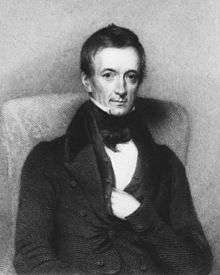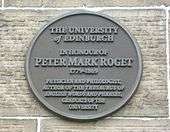Peter Mark Roget
Peter Mark Roget LRCP FRS FRCP FGS FRAS (UK: /ˈrɒʒeɪ/ US: /roʊˈʒeɪ/;[1][2] 18 January 1779 – 12 September 1869) was a British physician, natural theologian, lexicographer and founding Secretary of The Portico Library[3]. He is best known for publishing, in 1852, the Thesaurus of English Words and Phrases, a classified collection of related words. He also submitted a paper to the Royal Society documenting the phi phenomenon in 1824[4].
Peter Mark Roget LRCP FRS FRCP FGS FRAS | |
|---|---|
 | |
| Born | 18 January 1779 London, England |
| Died | 12 September 1869 (aged 90) West Malvern, England |
| Alma mater | University of Edinburgh |
| Spouse(s) | Mary Taylor Hobson (1824–1833) |
| Children | 2 |
Early life

Peter Mark Roget was born in London, the son of Jean (John) Roget (1751–1783), a Genevan cleric, and his wife Catherine Romilly, sister of Samuel Romilly.[5][6] After his father's death, the family moved to Edinburgh, in 1793, and he shortly began to study medicine at the University of Edinburgh, graduating in 1798.[5] Samuel Romilly, who had supported his education, also introduced Roget into Whig social circles.[7]
Roget then attended lectures at London medical schools.[5] Living in Clifton, Bristol from 1798 to 1799, he knew Thomas Beddoes and Humphry Davy, and frequented the Pneumatic Institute.[8]
Not making a quick start to a medical career, Roget in 1802 took a position as a tutor to the sons of John Leigh Philips, with whom he began a Grand Tour, during the Peace of Amiens, travelling with a friend Lovell Edgeworth, son of Richard Lovell Edgeworth. When the Peace abruptly ended, he was detained as a prisoner in Geneva. He was able to bring his pupils back to England, in late 1803, but Edgeworth was held in captivity until Napoleon's fall.[5]
Medical career
Roget became, with help from Samuel Romilly, private physician to William Petty, 1st Marquess of Lansdowne, who died in 1805. He then succeeded Thomas Percival at Manchester Infirmary, and began to lecture on physiology. He moved to London in 1808, and in 1809 became a licentiate of the Royal College of Physicians. After an extended period of dispensary work and lecturing, in particular at the Russell Institution and Royal Institution, he was taken onto the staff of the Queen Charlotte Hospital in 1817.[5][7] He also lectured at the London Institution and the Windmill Street School.[9]
Sir Samuel Romilly committed suicide, dying in Roget's presence, in 1818. Roget had been called in as adviser by the family, following the death of Lady Romilly.[5]
In 1823 Roget and Peter Mere Latham were brought in to investigate disease at Millbank Penitentiary.[9] In 1828 Roget, with William Thomas Brande and Thomas Telford, submitted a report on London's water supply. In 1834 he became the first Fullerian Professor of Physiology at the Royal Institution. One of those who helped found the University of London in 1837, he was an examiner in physiology there. He gave up medical practice in 1840.[5]
Later life
Roget in later life became deaf, and was cared for by his daughter Kate.[5] He died while on holiday in West Malvern, Worcestershire,[10][11][12] aged 90, and is buried there in the cemetery of St James's Church.
Thesaurus
Roget retired from professional life in 1840, and by 1846 was working on the book that perpetuates his memory today.[5] It has been claimed that Roget struggled with depression for most of his life, and that the thesaurus arose partly from an effort to battle it.[13] A biographer stated that his obsession with list-making as a coping mechanism was well established by the time Roget was eight years old.[14] In 1805, he began to maintain a notebook classification scheme for words, organized by meaning.[5] During this period he also moved to Manchester, where he became the first secretary of the Portico Library.[15]
The catalogue of words was first printed in 1852, titled Thesaurus of English Words and Phrases Classified and Arranged so as to Facilitate the Expression of Ideas and Assist in Literary Composition. During Roget's lifetime the work had twenty-eight printings. After his death it was revised and expanded by his son, John Lewis Roget (1828–1908), and later by John's son, the engineer Samuel Romilly Roget (1875–1953).[5][16]
Other interests

Roget was elected a Fellow of the Royal Society in 1815, in recognition of a paper on a slide rule with a loglog scale. He was a secretary of the Society from 1827 to 1848.[5] On 9 December 1824, Roget presented a paper on a peculiar optical illusion to the Philosophical Transactions, which was published in 1825, as Explanation of an optical deception in the appearance of the spokes of a wheel when seen through vertical apertures.[17][18] The paper was noted by Michael Faraday and by Joseph Plateau, who both mentioned it in their articles that presented new illusions with apparent motion.[19][20] It has often been heralded as the basis for the persistence of vision theory, which has for a long time been falsely regarded as the principle causing the perception of motion in animation and film.[21] In 1834, Roget claimed to have invented "the Phantasmascope or Phenakisticope" in the spring 1831, a few years before Plateau introduced this first device that demonstrated stroboscopic animation.[22]
One of the promoters of the Medical and Chirurgical Society of London, which later became the Royal Society of Medicine, Roget was also a founder of the Society for the Diffusion of Useful Knowledge, writing a series of popular manuals for it.[7] He wrote numerous papers on physiology and health, among them the fifth Bridgewater Treatise, Animal and Vegetable Physiology considered with reference to Natural Theology (1834), and articles for the Encyclopædia Britannica. He was hostile to phrenology, writing against it in a Britannica supplement in 1818, and devoting a two-volume work to it (1838).[23]
A chess player, in an article in the London and Edinburgh Philosophical Magazine Roget solved the general open knight's tour problem. He composed chess problems, and designed an inexpensive pocket chessboard.[5][24]
Selected publications
- Treatises on Electricity, Galvanism, Magnetism, and Electro-magnetism. London: Baldwin and Cradock. 1832. LCCN 08007072.
- Animal and Vegetable Physiology Considered with Reference to Natural Theology. Bridgewater Treatises. I–II. London: William Pickering. 2009 [1834]. ISBN 9781108000086. LCCN 06011266.
- Thesaurus of English Words and Phrases (Fourth ed.). London: Longman, Brown, Green, and Longmans. 1856.
In literature
Canadian writer Keath Fraser published a story, "Roget's Thesaurus," in 1982, which is narrated in Roget's voice. He has Roget speak on his wife's death, from cancer.[25]
Roget also appears in Shelagh Stephenson's An Experiment with an Air Pump, set in 1799, as the only historical character. The play takes place in the fictional household of Joseph Fenwick, and Roget is one of Fenwick's assistants.[26]
A picture book biography of Roget entitled The Right Word: Roget and His Thesaurus was published by Eerdmans Books in 2014. It was named a Caldecott Honor book for excellence in illustration and won the Sibert Medal for excellence in children's nonfiction.[27][28]
Family
In 1824 Roget married Mary Taylor (1795–1833), daughter of Jonathan Hobson. They had a son John Lewis (1828–1908), and a daughter Kate.[5]
References
- Wells, John C. (2008). Longman Pronunciation Dictionary (3rd ed.). Longman. ISBN 978-1-4058-8118-0.
- Jones, Daniel (2011). Roach, Peter; Setter, Jane; Esling, John (eds.). Cambridge English Pronouncing Dictionary (18th ed.). Cambridge University Press. ISBN 978-0-521-15255-6.
- "THE PORTICO LIBRARY AND THE BANK PUBLIC HOUSE, Manchester - 1197930 | Historic England". historicengland.org.uk. Retrieved 17 May 2020.
- Boorsten, D J (1992). The Creators. A History of Heroes of the Imagination. New York: Random House. p. 740.
|access-date=requires|url=(help) - Murray, T. Jock. "Roget, Peter Mark". Oxford Dictionary of National Biography (online ed.). Oxford University Press. doi:10.1093/ref:odnb/24008. (Subscription or UK public library membership required.)
- Proceedings of the Huguenot Society of London. 9. Huguenot Society of London. 1911. p. 546.
- Desmond, Adrian (1992). The Politics of Evolution: Morphology, Medicine, and Reform in Radical London. University of Chicago Press. pp. 222–3. ISBN 9780226143743.
- Fullmer, June Z. (2000). Young Humphry Davy: The Making of an Experimental Chemist. American Philosophical Society. p. 131. ISBN 9780871692375.
- "Munks Roll Details for Peter Mark Roget". munksroll.rcplondon.ac.uk.
- Deaths England and Wales 1837–1983 – lists place of death as Ledbury, and expands "The district Ledbury spans the boundaries of the counties of Herefordshire, Hereford and Worcester and Worcestershire"
- "Obituary – Dr. Roget, F.R.S". Medical Times and Gazette. London: John Churchill and Sons: 395. 25 September 1869.
- Kendall, J. (2008). The Man Who Made Lists. G.P. Putnam's Sons. ISBN 9780399154621.
- Spiegelman, Arthur (28 March 2008). "The man who made lists to fend off depression". Reuters. Retrieved 4 May 2008.
- Mallon, Thomas (16 March 2008). "Obsessed (Agog, Beset, Consumed, Driven, etc.)". The New York Times. Retrieved 4 May 2008.
- Rennison, Nick (2015). Peter Mark Roget: The Man Who Became The Thesaurus - A Biography. Oldcastle Books. p. 30. ISBN 9781843447931.
- Lemco, I. (August 1999). "Roget's Engineering Successor [i.e. S. R. Roget]". Engineering Science and Education Journal. 8 (4): 177–183. doi:10.1049/esej:19990409. Retrieved 18 October 2009.
- Roget, Peter Mark (1824). "Explanation of an optical deception in the appearance of the spokes of a wheel when seen through vertical apertures".
- Crary, Jonathan (1992). Techniques of the Observer: On Vision and Modernity in the Nineteenth Century. MIT Press. p. 106 note 19. ISBN 9780262531078.
- Garnier, Jean Guillaume (1828). "Correspondance mathématique et physique, publ. Par mm. Garnier et Quetelet. (Royaume des Pays-bas)".
- https://archive.org/stream/journalofroyalin01roya#page/204/mode/2up
- Dwyer, Tessa; Perkins, Claire; Redmond, Sean; Sita, Jodi (25 January 2018). Seeing into Screens: Eye Tracking and the Moving Image. ISBN 9781501328992.
- "Bridgewater treatises on the power, wisdom, and goodness of God, as manifested in the creation". 1834.
- Haskins, Roswell Willson (1839). History and Progress of Phrenology: (Read Before the Western Phrenological Society, at Buffalo,). Steele & Peck. pp. 181–3 note.
- Mason, Adair Stuart (2004). 'Wasn't it Exciting!': A Compilation of the Work of A. Stuart Mason. Royal College of Physicians. p. 73. ISBN 9781860162060.
- Metcalf, John (2007). Shut Up He Explained. Biblioasis. p. 286. ISBN 9781897231746.
- "Theatre review: An Experiment with an Air Pump at Lion and Unicorn Theatre". British Theatre Guide.
- "The Right Word: Roget and His Thesaurus, Awards & Grants". www.ala.org.
- "The Right Word: Roget and His Thesaurus, Awards & Grants". www.ala.org.
Further reading
- Anderson, John; Anderson, Barbara (1993). "The Myth of Persistence of Vision Revisited". Journal of Film and Video. 45 (1): 2–12.
- Anderson, John; Fisher, Barbara (1978). "The Myth of Persistence of Vision". Journal of the University Film Association. 30 (4): 3–8.
- Emblen, Donald Lewis (1970). Peter Mark Roget: the word and the man. London: Longman. ISBN 978-0582108271.
- Kendall, Joshua (2008). The Man Who Made Lists: love, death, madness, and the creation of "Roget's Thesaurus". New York: G. P. Putnam's Sons. ISBN 9780399154621.
External links
| Wikimedia Commons has media related to Peter Mark Roget. |
| Wikisource has original works written by or about: Peter Mark Roget |
- Works by Peter Mark Roget at Project Gutenberg
- Works by or about Peter Mark Roget at Internet Archive
| Academic offices | ||
|---|---|---|
| Preceded by |
Fullerian Professor of Physiology 1834–1837 |
Succeeded by Robert Edmond Grant |